Cohousing Post Pandemic
By Charles Durrett
Republished from The Cohousing Company’s November 2021 News & Updates
Seventy-four percent of the population get a significant sense of community and daily company from their workplace.(1) Camaraderie, Friday night beers, relationships big and small. I know that I have over the years. The number one indicator for longevity is daily interaction. Howdy to the postman; to the delivery person; coworker a, b, and c; and neighbors. Number two is community connections—who can I depend on to bring me a bowl of chicken soup when I have a cold? (2)
The pandemic shifted that and many of the associated rituals that went with it like listening to your favorite talk radio on the way to work or reading the paper or books on public transit. We had about 30 of the 54 residents in Nevada City Cohousing that worked entirely or partially during the pandemic at home. But we also had 7:00 pm music playing, 6:00 pm common dinners and potlucks (separated of course). Cohousers are clever and responsible. Planting and harvesting at 8:00 am, farmer's market on Thursdays at 5:30 pm, and plenty of get-togethers, in the way of walks, meetings and even outdoor movies in between. Masked and separated. At Nevada City Cohousing we say that we are socially distanced, but not socially isolated.
Three people that grew up in Nevada City Cohousing (Jessie, Dominic and Joy) and now they all live and work in Washington D.C.. They all know how to work with people because they grew up in cohousing.
So working at home is getting more and more popular. That sounds like back to the village—being around during the day. But in general, where is the community going to be if I work at home. Enter cohousing—many of my neighbors have said, "Thank god that they lived in cohousing during the pandemic."
Going from 10 to 4 employees alone made a difference in my workplace community. Working at home was truly mitigated by living in cohousing. The same was true for the school kids. So much tutoring went on on the front porches in cohousing regarding math, music, essays, exercise, and much more. Maybe the future will be the village or at least village life (cohousing) will be a part of the increasing reality. And given our overall environmental advantages—one resident announced that for 20 years pre-cohousing/pre-pandemic he bought 5–6 tanks of gas and later (also pre-pandemic) uses less than one per month. Our average household used 350,000 gal of water per year and now used less than 70,000 gal per year living in cohousing, and hundreds of other positive indicators.
Isolation is real—but it doesn't have to be.
1. "Loneliness and The Workplace", 2020 U.S. Report, retrieved from: https://www.cigna.com/static/www-cigna-com/docs/about-us/newsroom/studies-and-reports/combatting-loneliness/cigna-2020-loneliness-report.pdf
2. Susan Pinker, "The secret to living longer may be your social life", Ted Talk, retrieved from: https://www.ted.com/talks/susan_pinker_the_secret_to_living_longer_may_be_your_social_life/transcript?fbclid=IwAR2qh2Sv-wGNd3vu3zCtiHTKcRORtARJMSUgeQ69O41G1iZ3J4j1VNodiWI
Left photo by Charles Durrett: Nevada City Cohousing, CA; Right photo by Jessie Durrett: Three people that grew up in Nevada City Cohousing (Jessie, Dominic and Joy) and now they all live and work in Washington D.C.. They all know how to work with people because they grew up in cohousing.


